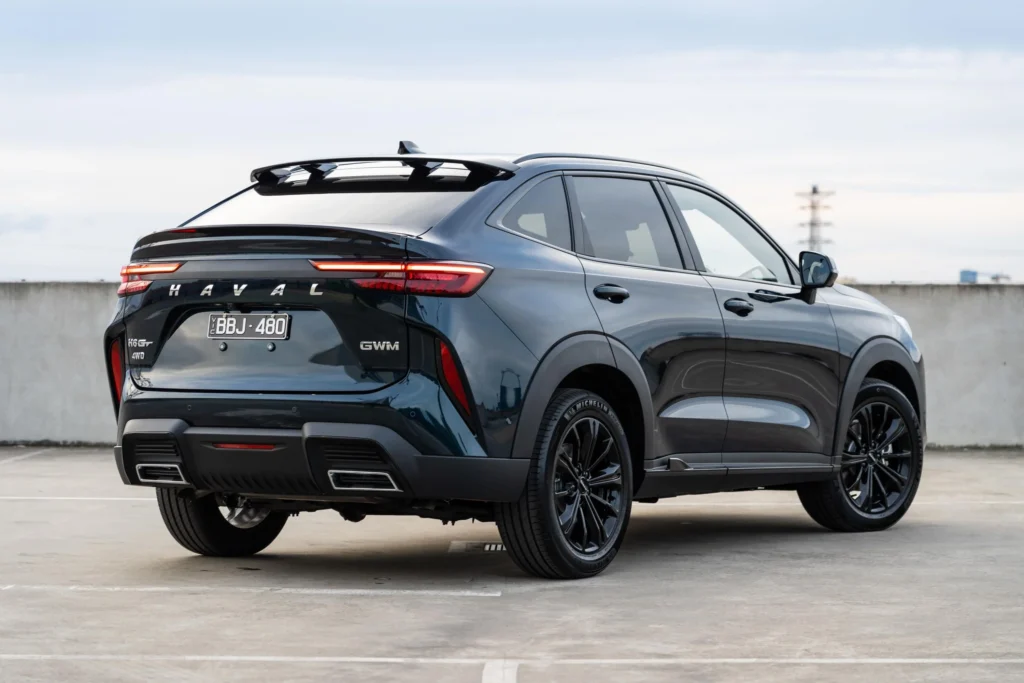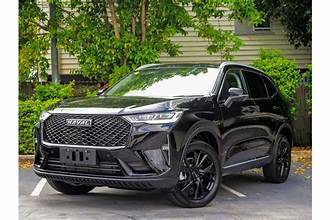The H6 GT takes the familiar H6 platform and gives it a sport-back roofline, bolder aero, and a more driver-centric setup. Think of it as a stylish fastback that still carries the family, eats up cargo, and doesn’t punish you at the pump. If you’ve been torn between a compact hatch and a small SUV, this is the in-betweener that aims to deliver the stance and space of an SUV with the tidy feel and swagger of a hot hatch.
Quick spec snapshot
| Item | H6 GT Turbo (typical spec; may vary by market) |
|---|---|
| Engine | 2.0-litre, 4-cyl turbo petrol |
| Output (approx.) | 150–155 kW (201–208 hp) |
| Torque (approx.) | 320–380 Nm |
| Transmission | 7-speed dual-clutch (DCT) |
| Drivetrain | FWD or AWD (market-dependent) |
| 0–100 km/h (claimed/typical) | ~7.5–8.5 s |
| Combined fuel use (typical) | ~7.5–8.8 L/100 km (mixed) |
| Fuel type | Unleaded petrol |
| Seats | 5 |
| Body style | Coupé-inspired fastback/SUV |
Figures are representative; exact numbers depend on region, trim, and homologation.
Dimensions & capacities
| Measurement | Approximate Value |
|---|---|
| Length | 4,68–4,73 m |
| Width | ~1,88 m (mirrors folded) |
| Height | ~1,73 m |
| Wheelbase | ~2,73 m |
| Ground clearance | ~170–190 mm |
| Boot/cargo volume (rear seats up) | ~390–500 L (variable by trim and spare wheel) |
| Fuel tank | ~60 L |
| Kerb weight | ~1,6–1,7 tonnes |
These dimensions put the H6 GT right in the sweet spot for tight urban streets while still offering the long-trip comfort and stability of a longer wheelbase.
Feature highlights (by area)
| Area | Key Features (typical) |
|---|---|
| Exterior | Coupé roofline, sporty bumpers/diffuser, dual spoilers (market-dependent), 19–20″ alloys, full LED lighting, sequential indicators, panoramic sunroof (select trims) |
| Cabin & Comfort | Dual 10–12.3″ screens (cluster + infotainment), soft-touch dash, sporty seats with bolstering, power driver seat, dual-zone climate, rear AC vents, generous storage, ambient lighting |
| Connectivity | Apple CarPlay/Android Auto (wired/wireless varies), Bluetooth, multiple USB-A/USB-C ports, wireless charging pad (select trims), connected app features (region-dependent) |
| Driver Tech | 360° camera, parking sensors, head-up display (some markets), selectable drive modes (Eco/Normal/Sport/Snow/Off-road on AWD) |
| Safety & ADAS | AEB with pedestrian/cyclist detection, adaptive cruise with stop-go, lane keep & lane centering, blind-spot monitoring, rear cross-traffic alert, traffic sign recognition, safe-exit warning, 6–7 airbags |
| Chassis & Dynamics | Multi-link rear suspension, tuning biased for daily comfort with a firmer Sport mode, AWD torque vectoring by brake (AWD trims) |
| Practicality | 60:40 rear split fold, flat-ish load bay, ISOFIX outer rear seats, keyless entry & start, power tailgate (trim-dependent) |

Pricing (indicative only; varies by country, taxes, and trim)
Note: Prices below are broad estimates for brand-new H6 GT Turbo models and should be confirmed with local dealers. They are provided to give you a sense of market positioning.
| Trim (example structure) | Drivetrain | Indicative Price Range* |
|---|---|---|
| H6 GT Turbo — Standard | FWD | USD $31,000–$34,000 |
| H6 GT Turbo — Mid (Sport/Elite) | FWD or AWD | USD $34,000–$37,500 |
| H6 GT Turbo — Top (Ultra/Performance) | AWD | USD $37,500–$41,500 |
*Equivalent value before local registration charges; currency conversions, duties, VAT/GST, freight, and dealer fees can move the final drive-away price up or down considerably.
If your market offers bundled service packs or extended warranties, factor those into the total cost of ownership—they can make the GT more compelling over 3–5 years.
What makes it feel like a “modern hatchback” (even though it sits higher)
1) Coupé stance, hatch practicality. The fastback profile cuts visual bulk and adds drama, yet you still get a tailgate opening and a usefully square load floor. That means stroller-and-groceries ease of use, plus weekend baggage swallowing without sweat.
2) Turbo urgency without punishing economy. The 2.0-litre turbo brings mid-range shove that makes the GT feel brisk in cut-and-thrust traffic. Selectable drive modes wake it up for on-ramps, then dial back for commuting efficiency. Expect real-world fuel consumption to live near the high-7s to low-8s (L/100 km) in mixed driving if you’re gentle; enthusiastic driving will push it higher.
3) DCT that prefers smooth inputs. The 7-speed dual-clutch gives snappy upshifts when you’re on it; in crawling traffic, a light right foot helps it behave like a torque-converter auto. Sport mode sharpens responses; Normal mode keeps things relaxed.
4) Cabin tech that feels current. The dash design leans minimalist—few hard buttons, crisp screens, tidy menus. Wireless charging and a 360° camera are big quality-of-life wins. The driver assistance stack (adaptive cruise + lane centering) reduces fatigue on long drives.
5) Ride/handling balance. While the GT has a sportier brief, the chassis tuning remains comfort-first. It’s composed over patchy tarmac and confident at motorway speeds, with the AWD grade adding extra traction in heavy rain or on dusty byways.
Deep feature rundown
Powertrain & performance
- Engine: A 2.0-litre four-cylinder turbo is the heart of the GT. The appeal here is torque: effortless overtakes in the 60–100 km/h band.
- Transmission: The DCT shifts quickly when you ask, with paddles on higher trims. In town, progressive throttle avoids low-speed lurch.
- Drivetrain: Markets typically offer FWD for price/value and AWD for all-weather grip and a touch more performance.
- Drive modes: Eco (sips fuel), Normal (balanced), Sport (sharper mapping), plus Snow/Off-road on AWD to optimize traction.
- NVH: Cabin isolation is competitive; road roar is well contained on OE tyres. Sport exhaust notes (if fitted) add a light rasp without drone.
Chassis, steering, and brakes
- Suspension: MacPherson strut front, multi-link rear—tuned for stability and comfort. Sport mode firms responses more than it stiffens the ride.
- Steering: Light at parking speeds, weights up naturally as speed builds; decent on-centre feel for motorway cruising.
- Brakes: Strong initial bite with predictable modulation; higher trims may gain larger rotors or a more performance-oriented pad compound.
Interior & usability
- Seating: Supportive front buckets with noticeable bolstering; powered driver seat on many trims. Rear headroom is better than the sleek roofline suggests.
- Storage: Deep door bins, covered centre bin, phone shelf with wireless charger, and cupholders that actually grip.
- Infotainment: Big, bright touchscreen with smartphone mirroring. OTA updates and app-connected features may be available regionally.
- Climate: Dual-zone with rear vents; cabin cool-down is quick. Cabin filtration keeps dust and pollen at bay.
Safety & driver assistance (ADAS)
- Active safety: AEB (cars, pedestrians, cyclist detection), lane keep + lane centering, blind-spot, rear cross-traffic, and speed sign recognition aim to reduce incidents.
- Passive safety: Multiple airbags (front, side, curtain), rigid passenger cell, and ISOFIX anchors for child seats.
- Driver aids on long trips: Adaptive cruise with stop-go plus lane centering add a semi-hands-on motorway experience; always remain attentive and hands-on per regulations.

Ownership experience
Running costs
- Fuel: The turbo engine prefers good-quality unleaded. Mixed driving tends to land you in the high-7s to mid-8s L/100 km depending on traffic and load.
- Tyres & brakes: 19–20″ wheels look ace but mean pricier tyres; rotation helps longevity. Brake wear is typical for the segment.
- Service intervals: Vary by region; many markets target 10,000–15,000 km or 12 months, whichever comes first. Ask about pre-paid service packs.
Reliability & warranty
- Warranty: Competitive factory coverage in most regions (commonly 5–7 years and/or distance-based caps). Paint and corrosion warranties complement.
- Software: Infotainment firmware updates can add features or fix bugs. Keep the system current for the best experience.
Who should buy the H6 GT Turbo?
- Style-first shoppers who don’t want to give up real utility.
- Urban families or couples needing an easy-park daily with weekend flexibility.
- Commuters who appreciate ADAS and a refined cabin but still want a lively throttle.
- Drivers in mixed climates, especially if AWD is on the table.
Pros, cons, and good-to-know
What you’ll like
- Distinctive fastback look versus boxier rivals.
- Strong mid-range torque; effortless around town and on highways.
- Rich tech and safety kit for the money.
- Comfortable ride with grown-up cabin refinement.
- Practical hatch opening and fold-flat flexibility.
What to watch
- DCTs prefer smooth throttle at low speeds—practice feathering in heavy traffic.
- Larger wheels look great but add tyre replacement cost and can sharpen bump impacts.
- Sloping roofline can slightly reduce ultimate cargo height versus a square-tail SUV.
Buying tips & trim guidance
- Decide on AWD early. If you live where it rains/snows often or you head off the beaten path, AWD is worth it. It also tends to bundle higher-grade features (360° camera, premium audio, etc.).
- Check your must-haves. If wireless charging, a panoramic roof, or a head-up display matters, verify they’re included on your region’s trim names (e.g., “Sport,” “Elite,” “Ultra”).
- Test low-speed manners. In a short test drive, include a car-park crawl and a steep ramp start to ensure you like the DCT feel.
- Budget for tyres. If your car gets 20″ rims, ask about tyre sizes and costs up front.
- Lock in service packs. Pre-paid servicing can smooth costs and help with resale later.
Extended feature table (trim-style view)
| Feature | Standard | Mid (Sport/Elite) | Top (Ultra/Performance) |
|---|---|---|---|
| 2.0T engine & 7-DCT | ✔️ | ✔️ | ✔️ |
| FWD / AWD | FWD | FWD or AWD | AWD |
| 19–20″ alloys | 19″ | 19–20″ | 20″ |
| LED head/tail lights | ✔️ | ✔️ (with sequential turns) | ✔️ (adaptive/auto high-beam where available) |
| Panoramic sunroof | — | Optional/✔️ | ✔️ |
| Power tailgate | — | ✔️ | Hands-free ✔️ |
| 360° camera | — | ✔️ | ✔️ (higher resolution) |
| Parking sensors (F/R) | ✔️ | ✔️ | ✔️ |
| Digital cluster + large touchscreen | ✔️ | ✔️ (larger) | ✔️ (largest) |
| CarPlay/Android Auto | ✔️ | ✔️ | ✔️ |
| Wireless charging | — | ✔️ | ✔️ |
| Upholstery | Fabric | Fabric/Leatherette | Leatherette/Leather (region) |
| Driver seat power & memory | — | Power | Power with memory |
| ADAS suite (AEB, ACC, LKA, BSM, RCTA) | ✔️ | ✔️ (with lane centering) | ✔️ (full suite + customization) |
| Premium audio | — | Optional | ✔️ |
| Ambient lighting | — | ✔️ | ✔️ (multi-color) |
(“—” indicates typically not fitted on that trim in many markets; always check your local spec sheet.)

Real-world impressions
- In town: Light steering and a tight turning circle make it feel smaller than it looks. Visibility is fine; the 360° camera is confidence-boosting in narrow streets.
- On the motorway: Stable and quiet, with easy passing power. Adaptive cruise plus lane centering reduce the grind on long runs.
- Back roads: Sport mode wakes the powertrain; body control is tidy for a high-riding fastback. It’s not a track toy, but it’s engaging enough to be fun on a Sunday morning.
Final word
If you want a family-practical daily that doesn’t fade into car-park anonymity, the Haval H6 GT Turbo belongs on your shortlist. It blends hatchback convenience with fastback style and a confident turbo powertrain, wraps it in a tech-rich cabin, and usually lands at a price that undercuts premium-badge rivals. The key is to pick the trim that matches your must-have features, try the DCT in traffic to ensure you like its feel, and confirm your local pricing and service packages to maximize value.
